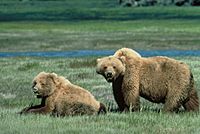Caniforms facts for kids
Quick facts for kids CaniformsTemporal range: Palaeocene- Recent
|
|
|---|---|
 |
|
| Grizzly bears | |
| Scientific classification | |
| Kingdom: | |
| Phylum: | |
| Class: | |
| Order: | |
| Suborder: |
Caniformia
Kretzoi, 1943
|
| Families | |
|
|
Caniformia is a group of animals that are part of the Carnivora order. Think of them as the "dog-like" mammals. This group includes many animals you might know, like bears, seals, and all kinds of dogs.
One big difference between these animals and the "cat-like" animals (called Feliformia) is their claws. Caniforms have claws that they cannot pull back into their paws. This is different from cats, who can hide their claws.
Contents
What are Caniforms?
Caniforms are a suborder of mammals. This means they are a smaller group within a larger one. The larger group is called Carnivora. This order includes all meat-eating mammals.
Caniforms are known for their dog-like features. They often have longer snouts and a different jaw structure compared to cat-like carnivores.
Families of Caniforms
The Caniformia group is made up of several different families. Each family has its own unique animals. Here are some of the main families:
Dogs, Wolves, and Foxes
The Canidae family includes all the dogs, wolves, and foxes. These animals are often known for living in packs and being very social. They are found all over the world.
Bears
The Ursidae family includes all types of bears. This includes big animals like polar bears and grizzly bears. Bears are usually large and strong. They can live in many different habitats.
Red Pandas
The Ailuridae family has only one living member: the red panda. These cute animals are much smaller than giant pandas. They live in the mountains of Asia.
Skunks
The Mephitidae family includes skunks and stink badgers. These animals are famous for their strong-smelling spray. They use this spray to defend themselves from danger.
Weasels, Otters, and Badgers
The Mustelidae family is a large group. It includes weasels, otters, badgers, and ferrets. These animals are often long and slender. Many of them are very good hunters.
Raccoons
The Procyonidae family includes raccoons, coatis, and olingos. Raccoons are known for their masked faces and clever paws. They are often found in forests and even in cities.
Seals and Walruses
This group is called Pinnipedia. It includes animals that live mostly in the water. They have flippers instead of paws. There are three main families within Pinnipedia:
- Odobenidae: This family has only one living member, the walrus. Walruses are known for their long tusks.
- Otariidae: These are the eared seals. They include sea lions and fur seals. They can "walk" on their flippers on land.
- Phocidae: These are the earless seals, also called true seals. They cannot "walk" on their flippers as easily on land.
Where Caniforms Live
Caniforms live in almost every part of the world. You can find them in cold arctic regions, hot deserts, dense forests, and even in the oceans. Their ability to adapt to different environments is amazing.
For example, polar bears live in the Arctic. Raccoons live in North America. Many types of seals live in oceans around the globe.
Size of Caniforms
Caniforms come in many different sizes. The largest land caniform is the polar bear. It can weigh over 1,500 pounds (680 kg).
On the other hand, the smallest caniform is the least weasel. This tiny animal is only about 5-10 inches (13-25 cm) long. It weighs less than a small candy bar!
History of Caniforms
The earliest known ancestors of carnivores lived a very long time ago. One of the earliest was an animal called Miacis. It lived about 60 million years ago. These early animals slowly evolved into the many different carnivores we see today, including all the Caniforms.
Scientists study fossils to learn about how these animals changed over millions of years.
Images for kids
-
Polar bear, the largest terrestrial caniform
-
The smallest caniform is the least weasel.
-
New Zealand sea lion (Phocarctos hookeri)
-
Common raccoon (Procyon lotor)
See also
 In Spanish: Caniformia para niños
In Spanish: Caniformia para niños






